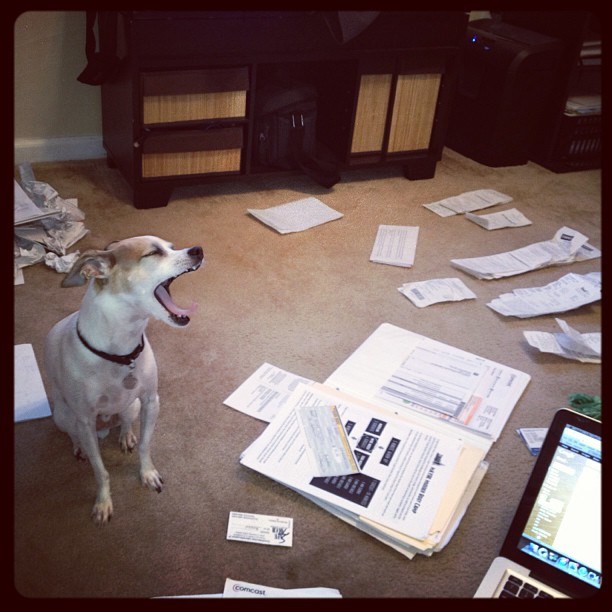The Small Business Quick Guide to Writing Proposals that Rock
Running a small business isn’t easy – to say the least.
When you run a small business, you have certain narrow priorities, that you’re sure to be keenly aware. This is especially the case if you are just starting up. Around here at Quote Roller, we talk about writing business proposals meant for the end-user or “customer” all the time. But, for fledgling entrepreneurs, it can seem like every day is all about proposals, with both internal and external objectives in mind. There are elevator pitches, meetings with investors, meetings with potential partners, meetings with the local business coalition, delivering great service, and the list goes on, and on…
At every stage of the game, it seems you are proposing something. Every day is an uphill battle to accomplish your goals and grow your business. It can be tough selling your dream to others, let alone selling your product or service!
We feel you, though!
We’ve put together The Small Business Quick Guide to Writing Proposals that Rock with you in mind. You may have ventured out onto the Web in search of info on streamlining your business proposals, only to find that the bulk of the information out there pertains to bigger businesses with complex legal needs, written in Puritan plain style or legalese, or whatever you want to call it. It doesn’t have to be that way, though, so don’t be discouraged.
Let’s take a look at the best proposal tips for small businesses. Along the way, we’ll support this guide with some of our free business proposal templates, just to get your started.
 Here is what we’ll look at:
Here is what we’ll look at:
- Business Plan
- Strategic Partnership Proposals
- Grant Proposals
- Other Proposals
The business plan
Regardless of what type of business you run, be it a tech startup, a small digital marketing agency, a web design firm, or anything else for that matter, you’ll have some basic needs that are standard across all types of businesses. Chief among those needs is the business plan. A business plan is a lot like a proposal, admittedly. But its function is slightly different. It can, however, inform your business proposals and lends itself to being re-purposed in all sorts of other proposals. So it’s out starting point.
Your company needs a business plan before it gets anything else, really. Since in the early stages of your business (and for a long time thereafter) you will need to “pitch” your business plan to various people, it’s a great idea to think of your business plan just as you would think of a business proposal, though there is a key difference between the two.
Take a look at our Business Plan Template to see an example of how to create your own business plan.
Let’s break down the basic parts of the Business Plan Template.
Page 1: Executive Summary
The Executive Summary section of the Business Plan is just like your elevator pitch in writing. It’s the short version of your story, condensed to a fun and engaging format that is meant to gain and retain the reader’s interest.
The executive summary is meant to give your reader an idea of what you’re about, before they go through the trouble of reading the whole plan. Think of why you are in business and share that here.
This section explains the purpose of your business – why should it exist?
Page 2: Mission Statement
The Mission Statement offers your reader (and you!) a clear understanding of your business.
Here you list the following:
- Business goals
- Objectives
- Customers
- Industry
- Strengths
- Status of ownership
At every step, be as specific, clear and correct as possible. Your readers are actually looking for flaws or omissions. They want to get a sense of how your business defines itself in your industry. Keep it transparent, but make sure it’s all there.
Page 3: Products and Services
In the Products and Services section you want to detail what is that you have to offer. You want to do more than just blandly list your goods. You want to explain what makes your offerings so great and, more importantly, special.
But don’t go for tech talk and specifications here. Instead, share some examples of usage. Also, be sure to list your pricing, and conclude with a bullet list of features and benefits.
Page 4: Marketing Plan
Once you’ve told your reader what your products and services are, it’s time to tell the reader how you plan to actually sell your output.
The Marketing Plan section can be broken down into six basic parts:
- Buyer Personas/Customers
- Competition
- Niche
- Distribution Channel(s)
- Promotion
- Message
In the past, we’ve discussed Marketing Mix. This is the section to tell your reader just how much you understand how marketing will factor into your business model and your success.
Page 5: Operations Plan
In the Operations Plan section, you will want to tell your reader how your business will operate on a day-to-day basis.
This section is meant to explain that you have given careful consideration to the small details in your business.
Here are the points to make in the Operations Plan section:
- Personnel
- Production/work performed
- Location
- Transportation
- Legal requirements/compliance
- Inventory/assets
- Suppliers/partners
- Accounting timelines
HOT TIP: If your product depends heavily on Intellectual Property (IP), savvy investors will definitely want to read about how you plan to manage and protect IP in your organization.
Page 6: Management Organization
Another important thing your readers will be looking for is a complete breakdown of the Management Organization within your company. You’ll want to list the Officers of your company, its board members, advisors, accountants, lawyers, and other key staffers. It doesn’t hurt to get creative and visual with this, from adding a hierarchical chart to smiling faces.
Management structure has a strong influence on how other business personalities will perceive your company, so spend some time on this section. Plus, it helps you put your entire team into perspective, too.
Page 7: Financial Plan
The Financial Plan section is probably the single most important part of your Business Plan. With great likelihood, this will be the longest section in your plan, and, with even greater likelihood, this is where your potential investors are spending the most time reading. Your investors will want to know as many details as possible about your business.
Here are the kinds of things you will want to list in the Management Organization section:
- Financial Position – What funds do you currently have? Do you have debt? Be sure to list it all.
- Cash Flow Spreadsheet – Income vs. expenses – the sales formula
- Profit/Loss – a 12-month view of your financial position
- Break-Even Analysis – When will you start making money? How much do you need to sell to become profitable?
Again, having a look at our free Business Plan template will help you get started on the right foot. The main thing to consider in a business plan is that it differs from other types of proposals. Whereas most business proposals end with a call to action (CTA), a Business Plan lacks an overt CTA because it is just that – a plan that you can’t afford to omit.
Strategic Partnership Proposals
 In a strategic partnership, two companies combine their resources to offer their respective customers an advantage. Often, this can be done to supplant an apparent shortcoming on the part of the partners. Other times, it’s simply a smart move. Quote Roller has several integration partners to expand the possibilities of what our proposal solution can do and to expand our client base.
In a strategic partnership, two companies combine their resources to offer their respective customers an advantage. Often, this can be done to supplant an apparent shortcoming on the part of the partners. Other times, it’s simply a smart move. Quote Roller has several integration partners to expand the possibilities of what our proposal solution can do and to expand our client base.
There are basically five steps in securing a strategic partner for your small business:
Step 1.
Determine if the company you want to partner with is right for your business. Does it offer a product or service that directly fills a gap in what you offer? If your business is too similar in nature, a partnership is ill-advised.
If, on the other hand, your business can complement the other like PayPal and eBay (referring, of course, to the time prior to the 2002 acquisition of the former by the latter), then you’re on the right track. (If only we could all be so lucky as Elon Musk, right?)
This is also a great time to follow your instincts.
Step 2.
Create a plan for the alliance. What will the trade-offs involved be? What is the goal for the alliance? The trick is to determine how the alliance will benefit you and the partner company. Here is the place for the “strategy” in this strategic partnership. How will it work? Who will be the point-of-contact within each company? What departments and teams will need to share ideas (and even IP) to get the job done? What sort of cross-marketing should be planned?
Step 3.
Create a proposal for the alliance. You can borrow a lot from the Business Plan we talked about above. Just keep in mind, this like all other proposals apart from the Business Plan, needs a compelling CTA. Want to know how to get there? We’ve got you covered on that, too.
Step 4.
Submit the proposal. Make sure you get it to the decision makers who can approve the partnership. If you know this person/these people well, you’ve probably got strong rapport with him or her, and can communicate beforehand. Remember to cover your asparagus, though, and submit the proposal in writing to solidify the deal. And, like always, making it an electronic transaction will make it much smoother and quicker.
Step 5.
Once you’re tendered the strategic partnership proposal, the recipient may have questions or want to make changes. Pick up the phone and call the decision-maker and see if you can hammer out the deal. Your proposal isn’t written in stone, after all. Using an electronic document and working in the cloud means you can annotate and send it back and forth, without worrying about disorganized versions.
PandaDoc eSignature feature automates the document signing process completely. It’s legally binding, is easy to use, and uses the same encryption that financial institutions around the world use to protect their data.
After that, it’s just a matter of signing and working together to make the most out of the partnership going forward.
Grant Proposals
The other crucial type of proposal that a small business might encounter is the grant proposal. You may have heard of other businesses getting various government or private grants to start or grow a business. You’ve probably even thought, “Dang, I wish I could get a grant.”
The truth is, in many cases, you can get a grant for your small business. But it’s not necessarily easy to do that.
There are very specific requirements for how a grant proposal should be formatted and submitted. You can find a wealth of resources online to help you with this, but the best source of help is to consult with the unique nonprofit or foundation that you plan to apply for a grant from. They will often publish guidelines for their grant applications.
Keep in mind that in the United States, the Federal Government does not offer general grants to small businesses. They do have some very specific grants for health research and development of certain types of products (like green innovations). While you can check Grants.gov to see if your business qualifies for any national-level grant monies, your best bet is to check with state a local governments, as they tend to offer more funds to drum up business. Look for funding options like The Amber Foundation and California’s Startup Funding Challenge.
In addition, remember, there are many partnerships that can be had with big companies who need different definitions of diversity to receive partnerships. For example, a big construction firm might only get a federal grant if they were to partner with a company of fewer than five people — perfect for electricians, plumbers, and other small, specific business owners. Definitely keep up-to-date on issues like this by listening to our friend Eileen Kent’s online radio show the Federal Sales Sherpa.
That being said, a recent article at Forbes lists the top states with aggressive small business funding initiatives. If you’re lucky enough to live in one of the areas, check the links for grant information in each respective state, listed below:
HOT TIP: The best advice we can give you on the highly-detailed subject of writing a grant proposal is that, in most cases, the reason for a proposal being declined is that it does not sufficiently clarify your “fit” with the funding party. For this reason, you will want to do your homework before submitting any grant proposals to make sure you understand your audience, as well as to be certain that your business really fits their mission. Also, even more than with a normal small bid, read the instructions with a fine-toothed comb!
Other Proposals
 As mentioned at the top of this article, a small business owner’s life is filled with proposals. No matter what type of business you are engaged in, chances are, you’re going to need to send business proposals on a regular basis.
As mentioned at the top of this article, a small business owner’s life is filled with proposals. No matter what type of business you are engaged in, chances are, you’re going to need to send business proposals on a regular basis.
That’s why Quote Roller has a stash of free proposal templates for your convenience. At some point, after all the funds have been raised, the grants received, and the partners secured, it comes time to face the customers and grow your company. That’s where it becomes critically important to get comfy with the sales process and practice creating winning CTAs.
Want the inside track?
Check out these business proposal templates (and about 30 more!), which represent some of our most popular industries:
- Web Design Proposal Template
- Graphic Design Proposal Template
- Marketing Proposal Template
- SEO Proposal Template
- Branding Proposal Template
- WordPress Web Design Proposal Template
- Accounting Proposal Template
- …and even an all-around Business Plan Template!
There’s your jump-starting inside track, folks!
Small business: Built on great proposals
Your business undoubtedly has a strong need for winning proposals. Business proposals go out in a variety of directions, but their success always comes down to careful planning. For businesses of all sizes, often, the challenge is identifying the opportunities to submit a proposal. Those opportunities extend well beyond the expected customer interactions (though that’s still the biggie), to include opportunities both internal and external to your business.
Whether you have a company at the seed funding stage or at the growth stage, proposals surely play a big role in what you do.
We’d love to know how you’re using proposals behind the scenes, as well as in customer interactions. What works for you?
Photos: Quote Roller Client Tales





Comments